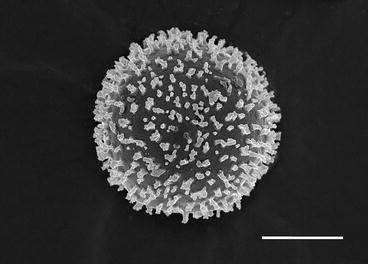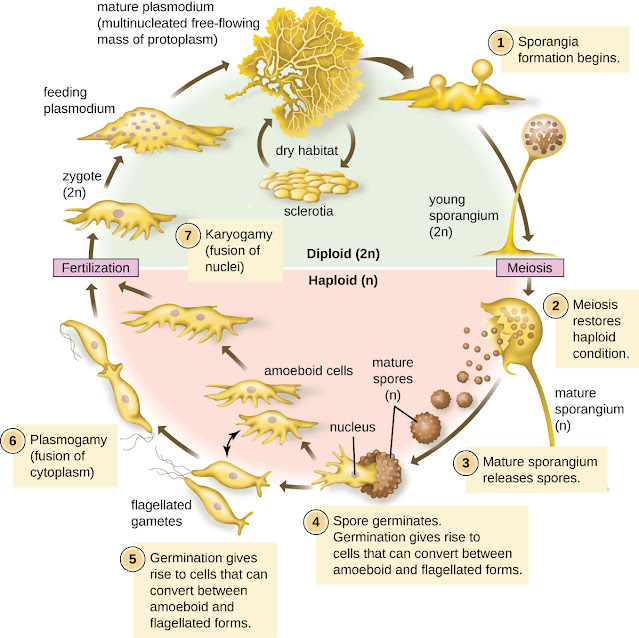Myxomycota: Unveiling the Enigmatic World of Slime Molds
Myxomycota, commonly known as slime molds, occupy a unique
niche in the fungal kingdom. Despite their name, they are not true fungi but
share certain characteristics with both fungi and protozoa. Let's delve into
the structure and life cycle of Myxomycota, revealing the fascinating biology
of these enigmatic organisms.
Structure of Myxomycota:
The structure of Myxomycota, commonly known as slime molds, involves distinct stages in their life cycle. These stages include the spore, myxamoebae, plasmodium, and sporangium. Let's delve into the structure of Myxomycota:
Spore:
- Structure: Myxomycota begin their life cycle as spores, which are typically small, single-celled structures.
- Function: Spores serve as the starting point for the development of Myxomycota and are designed for dispersal, being capable of withstanding adverse environmental conditions.
Myxamoebae:
- Structure: When spores germinate, they give rise to myxamoebae, which are amoeba-like, single-celled structures with a simple form.
- Function: Myxamoebae actively move and feed on bacteria, fungal spores, and organic matter during the vegetative phase of the life cycle.
Plasmodium (Vegetative Phase):
- Structure: Under certain conditions, myxamoebae may aggregate and fuse to form a multinucleate, gelatinous mass known as a plasmodium.
- Function: The plasmodium represents the feeding and growing stage of Myxomycota. It is a large, mobile mass that can engulf and consume nutrients from its environment.
Sporangium (Reproductive Structure):
- Structure: As the plasmodium matures or faces unfavorable conditions, it transforms into reproductive structures called sporangia. Sporangia vary in shape and size.
- Function: Sporangia house the structures responsible for spore production. They develop through the aggregation and differentiation of cells within the plasmodium.
Columella:
- Structure: Some sporangia may contain a central column-like structure called the columella.
- Function: The columella provides support within the sporangium, assisting in spore dispersal by creating a central axis.
Capillitium:
- Structure: Elongated, thread-like structures called capillitia radiate from the columella to the outer edge of the sporangium.
- Function: The capillitium supports the spores and helps create a network within the sporangium, aiding in the distribution of spores.
Life Cycle of Myxomycota:
1. Spore Germination:
- Initiation:
The life cycle begins with the germination of spores.
- Formation
of Amoeboid Cells: Germinating spores give rise to amoeboid cells, the
initial stage of the plasmodium.
2. Plasmodium Formation:
- Amoeboid
Cells Fusion: Amoeboid cells fuse to form a multinucleate mass—the
plasmodium.
- Vegetative
Growth: The plasmodium undergoes extensive vegetative growth,
exploring its environment in search of food.
3. Vegetative Stage:
- Feeding
and Growth: The plasmodium engulfs and absorbs nutrients through its
amoeboid movement.
- Environmental
Response: Responsive to environmental cues, such as light and
moisture, during its exploration.
4. Reproductive Stage:
- Conditions
for Reproduction: Environmental conditions, such as nutrient depletion
or desiccation, trigger the transition to the reproductive stage.
- Formation
of Fruiting Bodies: The plasmodium differentiates to form numerous
fruiting bodies, each containing a sporangium.
5. Sporangium Maturation:
- Spore
Development: Within the sporangium, spores undergo development.
- Differentiation:
Cells within the sporangium differentiate to form spores with protective
walls.
6. Spore Dispersal:
- Release
Mechanism: The mature sporangium releases spores through various
mechanisms, such as air currents or water splashes.
- Dispersal:
Dispersed spores can survive in adverse conditions until they encounter
suitable environments for germination.
7. Germination of Spores:
- Initiation
of New Life Cycle: Germinated spores initiate a new life cycle by
giving rise to amoeboid cells.
Environmental Significance:
- Ecological
Role: Myxomycota play a crucial role in nutrient cycling, breaking
down organic matter in their environment.
- Bioindicator:
Presence or absence of certain slime molds can serve as indicators of
environmental conditions.
Conclusion:
Myxomycota, or slime molds, showcase a fascinating
combination of fungal and protozoan characteristics. From the amoeboid movement
of the plasmodium to the intricate formation and dispersal of spores, their
life cycle is a testament to their adaptability and resilience in diverse
environments. Studying these unique organisms not only enriches our
understanding of biodiversity but also highlights the intricate interplay
between form and function in the natural world.
FAQs
1. What are Myxomycota?
- Myxomycota,
commonly known as slime molds, are microorganisms that belong to the
kingdom Protista. Despite their fungus-like appearance, they are not
classified as fungi.
2. Where are slime molds found?
- Slime
molds are often found in terrestrial habitats such as forests, decaying
logs, leaf litter, and other organic-rich environments. They thrive in
moist conditions and are more common during the rainy season.
3. Are slime molds harmful to plants or humans?
- No,
slime molds are not harmful to plants or humans. They primarily feed on
bacteria, fungal spores, and decaying organic matter. They do not pose a
threat to agriculture or human health.
4. Can slime molds move?
- Yes,
during their vegetative phase, slime molds, in the form of plasmodia, are
capable of slow movement. This movement is facilitated by the flow of
cytoplasm within their cell mass.
5. Do slime molds have a life cycle?
- Yes,
slime molds have a complex life cycle that involves spore germination, the
formation of amoeboid cells (myxamoebae), the development of a feeding
plasmodium, and the formation of reproductive structures (sporangia) that
release spores.
6. How do slime molds reproduce?
- Slime
molds reproduce through the release of spores. Spores are formed within
the sporangia, which develop from the plasmodium. These spores can be
dispersed by various means, such as wind or water.
7. Can slime molds be cultivated or studied in a
laboratory setting?
- Yes,
slime molds can be cultured and studied in a laboratory setting.
Researchers often use them as model organisms to explore various aspects
of cell biology, ecology, and evolution.
8. Are slime molds beneficial to the ecosystem?
- Yes,
slime molds play a role in nutrient cycling and decomposition. By feeding
on bacteria and organic matter, they contribute to the breakdown of dead
plant material, recycling nutrients back into the ecosystem.
9. Do slime molds have economic or industrial uses?
- While
slime molds are not extensively used in economic or industrial
applications, their study can provide insights into cellular processes and
may have potential applications in biotechnology and medicine.
10. Can slime molds be controlled or eliminated if they
appear in a garden or landscape?
- Slime
molds are generally harmless and do not require control measures. They are
a natural part of the ecosystem and contribute to soil health. If
appearance is a concern, physical removal is usually sufficient.
These FAQs provide a basic understanding of Myxomycota and
their role in ecosystems. Keep in mind that ongoing research may lead to new
insights and information about these intriguing organisms.




0 Comments